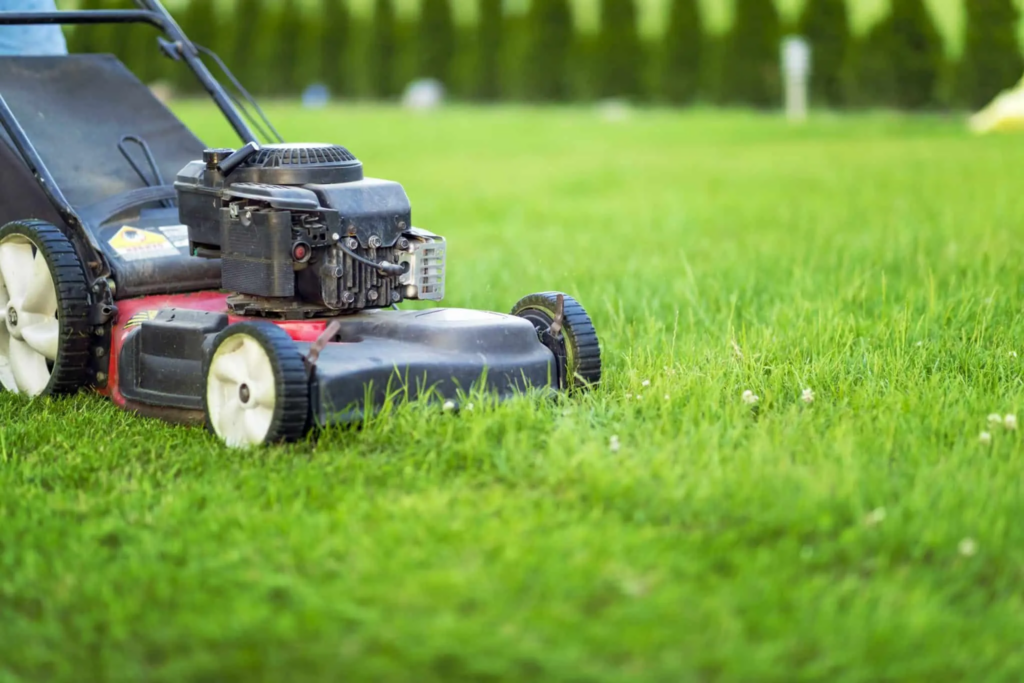Welcome to the world of lawn care, where every blade of grass tells a story of dedication and nurture. For many, the quest for a lush, vibrant lawn is not just a chore but a labour of love—a journey filled with triumphs, setbacks, and the ever-present promise of renewal.
Lawn care involves a range of practices, such as mowing, watering, fertilizing, weeding, and pest control to maintain a healthy and attractive lawn. Tailoring your lawn care routine to factors like grass type, soil condition, and climate for optimal results is essential.
Whether you’re a seasoned lawn enthusiast or a newcomer to the world of turf management, there’s something here for everyone as we uncover the art and science of lawn care.
Understanding Your Lawn – Unlock the Secrets of Your Lawn!
Before diving into the specifics of lawn care, it’s crucial to develop a deeper understanding of your lawn’s unique characteristics and requirements.

By taking the time to assess factors such as grass type, soil composition, and climate, you can tailor your lawn care routine to meet your lawn’s specific needs.
Grass Type:
The type of grass that makes up your lawn plays a significant role in determining how it should be cared for. Different grass species have varying characteristics, such as growth habits, water requirements, and tolerance to environmental conditions. Common grass types include:
- Cool-season grasses: Examples include Kentucky bluegrass, perennial ryegrass, and fescues. These grasses thrive in cooler climates and are typically found in northern regions.
- Warm-season grasses: Examples include Bermuda grass, Zoysia grass, and St. Augustine grass. These grasses are well-suited to warmer climates and are commonly found in southern regions.
Identifying the type of grass in your lawn will help you make informed decisions about mowing height, watering frequency, and other aspects of lawn care.
Soil Composition:
The composition of your soil has a significant impact on the health and vitality of your lawn. Factors such as soil texture, pH level, and nutrient content can affect how well your grass grows and responds to environmental stressors. Common soil types include:
- Sandy soil: Sandy soil is well-draining but tends to be low in nutrients. Regular applications of fertilizer and organic matter improve fertility and water retention.
- Clay soil: Clay soil holds moisture well but can become compacted, making it difficult for grass roots to penetrate. Aeration and soil amendments can help improve drainage and aeration in clay soil.
- Loamy soil: Loamy soil is considered ideal for lawn growth, as it has a balanced texture and good drainage. Regular maintenance, such as mowing, watering, and fertilizing, can help maximize the potential of loamy soil.
Conducting a soil test can provide valuable insights into your soil’s composition and help you develop a targeted lawn care plan.
Climate Considerations:
The climate in which you live plays a significant role in determining the best approach to lawn care.
Factors such as temperature, humidity, rainfall, and sunlight exposure can all influence how well your lawn grows and thrives. Consider the following climate considerations when caring for your lawn:
- Temperature: Different grass species have different temperature requirements for optimal growth. Cool-season grasses thrive in cooler temperatures, while warm-season grasses prefer warmer conditions.
- Rainfall: Adequate water is essential for a healthy lawn, but the amount of rainfall your area receives can vary significantly throughout the year. Be prepared to adjust your watering schedule based on seasonal rainfall patterns.
- Sunlight: Most grass species require ample sunlight to photosynthesize and grow. Evaluate the amount of sunlight your lawn receives throughout the day and choose grass species that are well-suited to your light conditions.
By considering these factors and taking the time to understand your lawn’s unique characteristics, you can develop a customized lawn care routine that promotes optimal growth and vitality.
Also Read: Who is tyler roby pippen – All You Need To Know In 2024
Optimizing Mowing Heights For A Healthy Lawn – Achieve The Perfect Mowing Height For Your Lawn!
Achieving the perfect mowing height is crucial for the health and appearance of your lawn. Here’s some more detailed information on finding the right mowing height for your grass:

1. Know Your Grass Type:
Different types of grass have different ideal mowing heights. Cool-season grasses, such as Kentucky bluegrass and fescue, typically thrive when mowed to a height of 2.5 to 4 inches. Warm-season grasses, like Bermuda grass and zoysia grass, prefer to be mowed shorter, usually between 1.5 to 2.5 inches.
2. Consider the Season:
Mowing height can vary depending on the time of year. In the spring and fall, when grass is actively growing, you can mow slightly shorter to encourage dense growth. In the hot summer months, raising the mowing height can help protect the grass from heat stress and drought.
3. Follow the One-Third Rule:
To avoid stressing the grass, never remove more than one-third of the grass blade in a single mowing session. Cutting the grass too short can weaken the plants and leave them more susceptible to pests, diseases, and environmental stressors.
4. Adjust for Shaded Areas:
Grass in shaded areas tends to grow taller and thinner than grass in full sun. To promote healthy growth in shaded areas, raise the mowing height slightly and avoid cutting the grass too short.
5. Sharp Blades are Key:
Dull mower blades can tear the grass instead of cutting it cleanly, leading to ragged edges and increased susceptibility to disease. Make sure to sharpen your mower blades regularly to ensure a clean, even cut.
6. Mow When the Grass is Dry:
Mowing wet grass can result in uneven cutting and clumping, as well as potential damage to the lawn. Aim to mow when the grass is dry for the best results.
7. Alternate Mowing Patterns:
Mowing in the same direction every time can lead to soil compaction and a striped appearance in the lawn. To promote even growth and reduce compaction, alternate your mowing pattern with each mowing session.
By following these guidelines and paying close attention to your lawn’s specific needs, you can ensure that you’re mowing at the optimal height for a healthy, attractive lawn.
Optimizing Watering Times For Your Lawn— Start Implementing These Watering Tips Today!
When it comes to watering your lawn, timing is indeed crucial. The goal is to ensure that your grass receives an adequate amount of moisture without wasting water through evaporation. Here’s a closer look at why timing matters and how to optimize your watering schedule for maximum effectiveness:
1. Early Morning is Best:
Watering your lawn early in the morning, preferably between 4 a.m. and 10 a.m., is generally considered the most efficient time. During these hours, temperatures are cooler, winds are usually calm, and the sun is not yet at its peak. This means that less water is lost to evaporation, allowing more of it to penetrate the soil and reach the grassroots where it’s needed most.
2. Avoid Midday Watering:
It’s best to avoid watering your lawn during the hottest part of the day, typically between 10 a.m. and 4 p.m. At this time, the sun is intense, temperatures are high, and evaporation rates are at their peak. Watering during these hours can result in significant water loss and may even scorch the grass blades. Additionally, wet grass during the heat of the day can create a humid environment that’s conducive to fungal diseases.
3. Evening Watering:
While watering in the evening is better than watering during the midday heat, it’s not ideal for several reasons. Firstly, watering in the evening can prolong the period of leaf wetness, which can increase the risk of fungal diseases. Secondly, cooler evening temperatures mean that water evaporates more slowly, leading to potential overwatering and waterlogging of the soil.
4. Adjust Based on Climate and Soil Conditions:
It’s essential to adjust your watering schedule based on your local climate and soil conditions. In hot, dry climates, you may need to water more frequently, while in cooler, more humid climates, less frequent watering may be sufficient. Similarly, sandy soils drain water more quickly than clay soils, so you may need to water more frequently on sandy soil to ensure adequate moisture penetration.
5. Use Technology to Your Advantage:
Consider investing in a programmable irrigation system or a smart sprinkler controller to automate your watering schedule and ensure optimal timing.
These systems can be programmed to water your lawn during the early morning hours when evaporation rates are lowest, taking the guesswork out of lawn watering.
By following these watering guidelines and adjusting your schedule based on the specific needs of your lawn, you can ensure that your grass receives the right amount of moisture at the right time, leading to healthier, more resilient turf. Remember, consistency is key when it comes to watering, so aim for regular, deep watering sessions rather than sporadic, shallow watering. Your lawn will thank you for it!
Also Read: Brief Explanation of CouchTuner – Know In 2024
Maximizing Fertilization For A Thriving Lawn – Feeding Your Lawn!
Fertilizing your lawn is like giving it a balanced diet to ensure it grows strong, healthy, and green. Here’s a deeper dive into the process of fertilization and some tips to help you get the most out of this crucial aspect of lawn care.

Understanding Fertilizers:
Fertilizers contain a blend of essential nutrients that your lawn needs to thrive, including nitrogen, phosphorus, and potassium (often referred to as NPK). These nutrients play specific roles in promoting healthy growth:
- Nitrogen (N): Stimulates leaf and stem growth, giving your lawn that lush, green appearance.
- Phosphorus (P): Promotes strong root development and overall plant vigor.
- Potassium (K): Helps improve disease resistance and drought tolerance.
In addition to these primary nutrients, fertilizers may also contain secondary nutrients like calcium, magnesium, and sulfur, as well as micronutrients like iron, manganese, and zinc, which are needed in smaller quantities but are still essential for plant health.
Choosing the Right Fertilizer:
When selecting a fertilizer for your lawn, it’s important to consider several factors, including:
- Grass Type: Different types of grass have different nutrient requirements. Warm-season grasses like Bermuda and Zoysia may have different needs than cool-season grasses like Kentucky Bluegrass and Tall Fescue.
- Soil Test Results: Conducting a soil test can help you determine your lawn’s specific nutrient needs and tailor your fertilizer application accordingly.
- Time of Year: Fertilizer formulations may vary depending on the time of year and the specific needs of your lawn. For example, a fertilizer labeled for spring use may contain higher levels of nitrogen to promote rapid growth during the growing season.
- Slow-Release vs. Quick-Release: Slow-release fertilizers gradually release nutrients over time, providing a steady supply to your lawn. Quick-release fertilizers, on the other hand, deliver nutrients more rapidly but may require more frequent applications.
Application Tips:
Proper application is key to getting the most out of your fertilizer. Here are some tips to help you apply fertilizer effectively:
- Read and Follow the Label: Fertilizer labels contain important information, including recommended application rates, timing, and safety precautions. Be sure to read and follow the instructions carefully.
- Use the Right Equipment: Spreaders are commonly used to apply granular fertilizers evenly across the lawn. Make sure your spreader is calibrated correctly to ensure accurate application.
- Water After Application: After applying fertilizer, water your lawn thoroughly to help activate the nutrients and prevent burning.
- Avoid Fertilizer Runoff: Avoid applying fertilizer before heavy rain or irrigation to prevent nutrient runoff and pollution of waterways.
- Consider Environmental Impact: Choose environmentally friendly fertilizers whenever possible, and be mindful of the potential impact of fertilizer runoff on local ecosystems.
Effective Strategies For Weed Control In Your Lawn – Keeping Your Lawn Weed-Free!
Weeds are the unwanted guests that can quickly take over your lawn if left unchecked. However, with a proactive approach to weeding, you can keep your lawn looking healthy and vibrant. Here’s some more detailed information on how to effectively control weeds:
1. Identify Common Weeds:
Before you can effectively control weeds, it’s essential to know what you’re up against. Common lawn weeds include dandelions, crabgrass, clover, and chickweed. Each type of weed may require a different approach for removal or control.
2. Hand Pulling:
For small infestations or individual weeds, hand Pulling can be an effective and environmentally friendly method of weed control.
Make sure to pull the entire weed, including the roots, to prevent regrowth. It’s best to do this when the soil is moist, making it easier to remove the entire plant.
3. Weed Control Products:
If hand pulling isn’t practical for larger weed infestations, consider using herbicides or weed control products. There are two main types of herbicides: selective and non-selective.
Selective herbicides target specific types of weeds without harming desirable plants, while non-selective herbicides will kill any plant they come into contact with. Read and follow the instructions on the product label carefully to ensure safe and effective use.
4. Pre-Emergent Herbicides:
Pre-emergent herbicides are applied to the soil before weed seeds germinate, preventing weeds from establishing themselves in the first place.
These products can be particularly effective for controlling annual weeds like crabgrass. Apply pre-emergent herbicides according to the manufacturer’s instructions, typically in the spring, before soil temperatures reach a certain threshold.
5. Post-Emergent Herbicides:
Post-emergent herbicides are used to control weeds that have already sprouted and are actively growing.
There are both selective and non-selective post-emergent herbicides available, so be sure to choose the appropriate product for your specific weed problem. Follow the application instructions carefully, and avoid applying herbicides on windy days to prevent drift.
6. Mulching:
Mulching can help suppress weed growth by blocking sunlight and preventing weed seeds from germinating.
Apply a layer of mulch around trees, shrubs, and flower beds to help keep weeds at bay. Organic mulches, such as wood chips or shredded bark, can also improve soil health as they break down over time.
7. Maintain a Healthy Lawn:
A thick, healthy lawn is your best defense against weeds. Proper mowing, watering, and fertilizing practices will help promote strong grass growth, making it more difficult for weeds to establish themselves.
Consider overseeding thin or bare patches of lawn to encourage denser turf and reduce opportunities for weeds to take hold.
By incorporating these strategies into your lawn care routine, you can effectively control weeds and maintain a lush, weed-free lawn that you can enjoy year-round. Remember to stay vigilant and address weed problems promptly to prevent them from spreading and becoming more challenging to control.
Also Read: What is Duonao? – All You Need To Know In 2024
FAQ’s:
1. How often should I mow my lawn?
It’s best to mow your lawn regularly, typically once a week during the growing season. However, the frequency may vary depending on factors such as grass type, weather conditions, and growth rate.
2. What is the best time of day to water my lawn?
The best time to water your lawn is early in the morning, preferably before 10:00 AM. This allows the water to penetrate the soil effectively without excessive evaporation.
3. How can I tell if my lawn needs to be aerated?
Signs that your lawn may need aeration include compacted soil, water runoff, and poor grass growth. You can also perform a simple “screwdriver test” by inserting a screwdriver into the soil. If it’s difficult to penetrate, your lawn may benefit from aeration.
4. How do I prevent weeds from taking over my lawn?
Regular maintenance practices such as proper mowing, watering, and fertilizing can help prevent weeds from establishing themselves. Additionally, consider using pre-emergent herbicides to prevent weed seeds from germinating.
5. When is the best time to fertilize my lawn?
The timing of fertilization depends on your grass type and climate. In general, it’s best to fertilize your lawn in the spring and fall when the grass is actively growing. Avoid fertilizing during periods of drought or extreme heat.
Conclusion:
Maintaining a healthy, vibrant lawn is a journey that requires dedication, patience, and a bit of know-how. Following the tips and techniques outlined in this article, you can create a beautiful outdoor space that you’ll enjoy for years.
Remember to tailor your lawn care routine to your yard’s specific needs, and don’t be afraid to seek professional advice if you encounter challenges along the way. With a little TLC, your lawn will be the envy of the neighbourhood in no time. Happy gardening!






